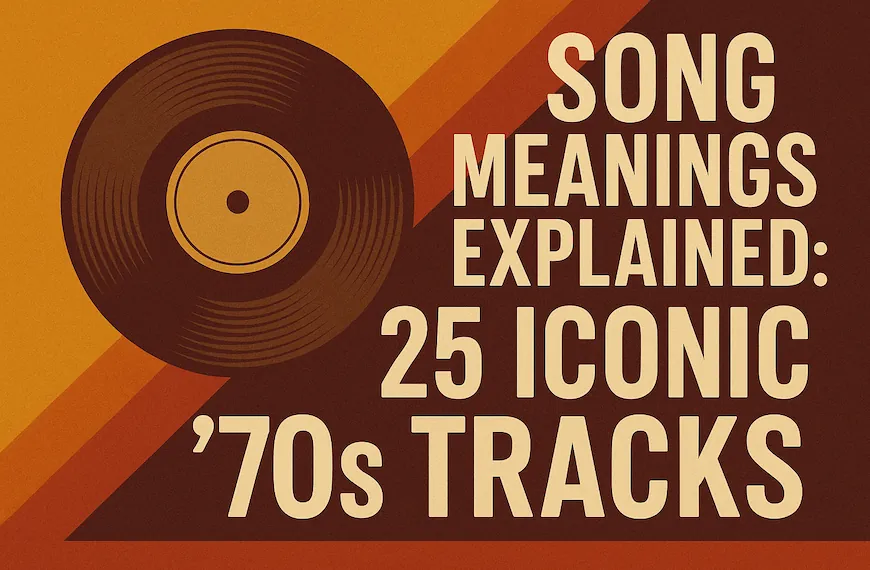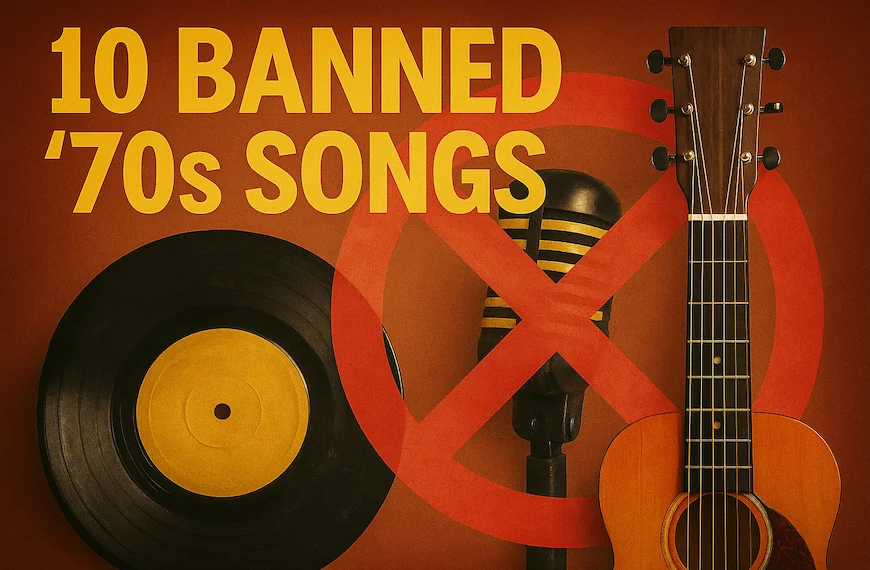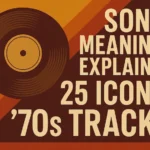When petroleum became a weapon of war, America’s music industry faced an unexpected enemy: chemistry itself.
In October 1973, as the Yom Kippur War raged in the Middle East, the Organization of Arab Petroleum Exporting Countries made a decision that would ripple through American culture in ways they never imagined. Their oil embargo didn’t just create gas lines and energy shortages. It nearly silenced the soundtrack of a generation by creating a major vinyl shortage.
Most music fans know 1973-74 as the era of Dark Side of the Moon, Goodbye Yellow Brick Road, and Led Zeppelin IV’s continued dominance. What they don’t realize is that these albums almost didn’t exist in the quantities we remember, and dozens of other potential classics were sacrificed on the altar of petroleum politics.
The Chemistry of Sound
The connection between Middle Eastern oil and American rock music wasn’t obvious to most people in 1973. Vinyl records seemed as far removed from gasoline as anything could be. But the plastic that carried the grooves of “Stairway to Heaven” and “Smoke on the Water” was polyvinyl chloride (PVC), a petroleum-based product that required substantial amounts of oil for manufacturing.
When the Arab oil embargo quadrupled petroleum prices overnight, the cost of producing vinyl skyrocketed. Record pressing plants, already operating on thin margins, suddenly faced a crisis. The raw materials for a single LP jumped from pennies to dollars. Small labels faced bankruptcy. Even major record companies found themselves making impossible choices: which albums deserved to exist?
The Triage Begins
By early 1974, record companies were operating like battlefield medics, performing musical triage. At Columbia Records, executives gathered in emergency sessions to decide which albums in their pipeline would live or die. A&R executives found themselves arguing not just for artistic merit, but for market certainty. Experimental albums, debut efforts from unknown artists, and anything deemed “risky” faced the chopping block.
The industry’s response created an accidental experiment in cultural Darwinism. Only the albums that record executives believed in most strongly or that had the most powerful advocates survived to pressing. This wasn’t entirely negative; it meant that many albums from this period represented labels’ absolute best bets, their most confident artistic statements.
But the casualties were enormous. Jazz albums, always marginal sellers, virtually disappeared from production schedules. Progressive rock bands found their elaborate double albums cut to single discs or shelved entirely. Regional artists who might have gained national distribution through smaller pressing runs simply vanished from the conversation.
The Bootlegger’s Paradise
The vinyl shortage created an unexpected black market. As legitimate pressings became scarce, bootleg operations flourished. These underground pressing plants, often operating with inferior equipment and recycled vinyl, churned out unauthorized copies of popular albums and rare live recordings. The quality was terrible with surface noise, poor fidelity, and off-center holes, but desperate fans bought them anyway.
Ironically, this bootleg boom introduced many listeners to music they might never have heard otherwise. Bob Dylan’s basement tapes, unreleased Beatles sessions, and live concerts by everyone from the Grateful Dead to Miles Davis circulated in fuzzy, crackling glory. The scarcity of official releases made any music feel precious, even if it sounded like it was recorded through a pillow.
The Great Repress
Record companies developed elaborate strategies to maximize their limited vinyl supplies. The most obvious solution was repressing proven sellers albums that were already hits could be counted on to move units quickly. This created a feedback loop where successful albums became even more ubiquitous while new releases struggled for shelf space.
Capitol Records, for instance, devoted enormous resources to keeping Beatles albums in print while delaying debut albums from newer artists. The result was that 1974 record stores were flooded with copies of “Abbey Road” and “Sgt. Pepper’s” while adventurous listeners struggled to find anything genuinely new.
Some labels got creative with their materials. A few pressing plants experimented with recycled vinyl, melting down unsold records to create new ones. Audiophiles claimed they could hear ghostly traces of previous recordings bleeding through a phenomenon that was probably psychological but felt spiritually appropriate for an era when all music seemed haunted by scarcity.
The Rise of the Cassette Underground
The vinyl shortage had an unintended consequence: it accelerated the adoption of cassette tapes. While vinyl became expensive and scarce, blank cassettes remained relatively affordable. Music fans who couldn’t find or afford the albums they wanted began taping them from friends, radio, or the rare opportunities when they could borrow originals.
This cassette culture created America’s first widespread music sharing network. College dorms became distribution centers for copied albums. Radio DJs found themselves inadvertently supporting piracy by playing entire album sides, knowing that listeners at home were hitting “record.” The music industry was horrified, but also secretly grateful at least people were still hearing new music, even if they weren’t buying it.
The Forgotten Albums
Perhaps the most tragic aspect of the vinyl shortage was the music that simply disappeared. Albums that were pressed in small quantities during 1974 became instant rarities, not because they were particularly good or bad, but because they barely existed in the first place.
Decades later, record collectors would pay hundreds of dollars for albums that failed not due to lack of quality, but due to lack of vinyl. Artists like Judee Sill, whose haunting folk albums were victims of the shortage, didn’t live to see their work rediscovered and celebrated. The shortage didn’t just affect what people heard in 1974, it shaped the entire trajectory of American music history.
Innovation Born of Desperation
The crisis forced the music industry to innovate. Labels began experimenting with alternative materials, different pressing techniques, and new distribution strategies. Some companies started pressing albums on lighter vinyl, creating records that were more fragile but used less material. Others explored colored vinyl not for aesthetic reasons, but because certain pigments could stretch the available plastic further.
The shortage also accelerated the development of more efficient pressing techniques. Plants that had operated the same way since the 1950s suddenly had incentives to maximize every gram of material. These innovations, born of desperation, later contributed to improvements in sound quality and durability that benefited the entire industry.
The End of Innocence
When the oil embargo ended in March 1974, vinyl supplies gradually returned to normal, but the music industry had been permanently changed. The crisis had revealed how fragile the entire system was, how dependent on global politics and petroleum economics. Record companies had learned to operate leaner, to take fewer risks, to calculate market potential more carefully.
The shortage also changed how fans related to music. Albums that had seemed disposable (things you could buy, listen to once, and forget) suddenly felt precious. The scarcity had taught an entire generation to value physical music objects in ways that would persist long after vinyl supplies returned to normal.
The Ripple Effects
The vinyl shortage of 1973-74 didn’t just affect what music was available; it influenced what music was created. Artists and producers, knowing that vinyl was scarce and expensive, began thinking differently about album construction. Why create a sprawling double album when a tight single disc might be more likely to get pressed? Why experiment with unusual sounds when conventional arrangements were safer bets for limited pressing runs?
These practical considerations subtly influenced the creative process. The shortage may have prevented some indulgent, experimental music from reaching listeners, but it also encouraged artists to focus their ideas, to make every song count. Some of the most memorable albums of the mid-70s reflected this enforced discipline.
Legacy of Scarcity
The vinyl shortage was a brief crisis lasting roughly eighteen months, but its effects on American music culture were lasting. It demonstrated the vulnerability of physical media, foreshadowed later format wars, and created the first generation of music fans who understood that their favorite songs weren’t guaranteed to be available forever.
More importantly, it showed how global politics could reach into the most intimate corners of American life. The same oil embargo that created gas lines and energy conservation also determined which albums a teenager in Ohio could buy at the local record store. In an era when music felt like the most important thing in the world, discovering that it was subject to the same forces as heating oil and gasoline was a sobering lesson in how interconnected modern life had become.
The crisis passed, the music flowed again, and vinyl records returned to seeming abundance. But for those who lived through it, the shortage left a permanent awareness of how precious and fragile the soundtrack of their lives really was. In the end, the oil embargo didn’t kill rock music, but it taught a generation that even the most powerful cultural forces could be silenced by something as simple as the price of petroleum.
















